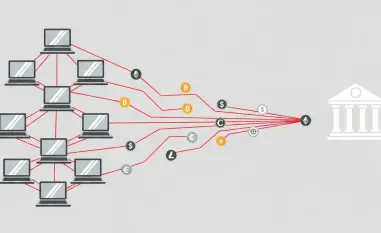Cryptocurrencies have revolutionized the financial landscape, offering a decentralized alternative to traditional fiat money. However, the increasing popularity and value of digital assets have also attracted the attention of cybercriminals. Protecting your crypto assets from cybersecurity threats is crucial to ensure the safety of your investments. This article explores various cybersecurity risks and provides practical tips to safeguard your crypto assets.
Understanding Cybersecurity Risks in the Crypto Space
As cryptocurrencies grow more widespread, the variety of cybersecurity risks evolves, posing significant challenges for users. From phishing attacks to zero-day vulnerabilities, the crypto space seems to endure recurring and new threats designed to exploit this lucrative market. The following sections will delve into the primary risks and strategies to mitigate them for any responsible crypto investor.
Phishing Attacks
Phishing attacks are one of the most common threats in the crypto space. Hackers use deceptive emails, texts, and websites to trick users into revealing sensitive information, such as seed phrases or private keys. These attacks often involve impersonating reputable crypto exchanges or services to create a sense of legitimacy and urgency.
To protect against phishing attacks, always confirm the legitimacy of any communication before engaging with it, especially if it requests personal information. Avoid clicking on links or downloading attachments from unknown sources. Two-factor authentication (2FA) adds an extra layer of security, making it harder for hackers to gain access to your accounts. Keeping abreast of common phishing tactics and scrutinizing communications can significantly reduce the likelihood of a successful attack.
Ransomware Attacks
Ransomware attacks involve malicious actors using malware to encrypt important files related to crypto wallets or private keys, rendering the data unreadable. Victims are then forced to pay a ransom, often in cryptocurrency, to regain access to their files. This type of attack has grown increasingly sophisticated and can be devastating for those unprepared.
To mitigate the risks of ransomware attacks, using cold wallets, which are offline and less vulnerable to cyber threats, is highly advisable. Regularly backing up your data ensures that, even if you are targeted, you have another way of accessing your critical information. Avoid downloading attachments or clicking on links from suspicious emails to limit exposure. This combination of offline storage and regular backups can help shield your assets from being held hostage by malicious actors.
Protecting Your Devices and Wallets
Securing your devices and crypto wallets is another critical component of protecting your digital assets. Without proper measures, your devices can become compromised, leaving your investments vulnerable to theft or loss. This section will cover how to safeguard your devices and wallets through various cybersecurity practices.
Malware Attacks
Malware attacks aim to compromise crypto wallets or devices to steal digital assets. One common form of this attack, known as crypto-jacking, involves malicious software infiltrating devices to mine cryptocurrencies using their computing power, leading to financial losses and potential damage to your devices. As malware becomes increasingly sophisticated, so must your defense mechanisms.
Installing robust anti-virus software is an effective way to protect against malware attacks. Always ensure your anti-virus software is kept up to date to benefit from the latest security patches and threat definitions. Additionally, downloading files only from reputable sources reduces the risk of accidentally installing malicious software. By combining these protective measures, you can decrease the likelihood of suffering a malware attack and preserve the integrity of your crypto assets.
Man-in-the-Middle (MitM) Attacks
Man-in-the-Middle (MitM) attacks occur when a hacker intercepts communication between a user and a crypto exchange to steal private keys or login credentials. This kind of attack can be particularly damaging as it often goes unnoticed until it’s too late. The intercepted communication could result in redirected crypto transactions to the hacker’s wallet, causing significant financial loss.
To reduce the risk of MitM attacks, avoid using public WiFi for crypto transactions, as these networks are more susceptible to being compromised. Instead, use a secure and private internet connection. Additionally, consider using a Virtual Private Network (VPN) to encrypt your online activities and protect your data from interception. A VPN can provide an added layer of security, making it more difficult for hackers to exploit your communications. Implementing these precautions can help safeguard your crypto transactions from potential eavesdroppers.
Staying Ahead of Emerging Threats
As cybersecurity threats continually evolve, staying ahead of them requires maintaining an adaptive security posture. The crypto space is dynamic, and hackers are constantly developing new techniques to exploit vulnerabilities. By anticipating and preparing for these emerging threats, you can better protect your digital assets.
Zero-Day Attacks
Zero-day attacks exploit vulnerabilities in crypto platforms, such as software or hardware wallets, before developers can identify and resolve these issues. These vulnerabilities provide hackers with an opportunity to steal crypto funds unchecked, making zero-day attacks particularly dangerous and challenging to defend against.
Developers must be diligent in identifying and patching any security gaps quickly to minimize the risk of exploitation. As a user, keeping your software updated is crucial for benefiting from the latest security enhancements. Staying informed about potential vulnerabilities and applying updates promptly can help protect your assets from zero-day exploits. In addition, consider participating in or following bug bounty programs, which encourage the discovery and reporting of security flaws before they can be exploited maliciously.
Adaptive Security Measures
As digital assets gain traction, hackers are becoming more sophisticated, employing advanced techniques to exploit vulnerabilities. Maintaining an adaptive security posture that evolves in response to emerging threats is essential for the long-term security of your crypto investments. Regularly reviewing and updating your security protocols can help you address new risks as they arise.
Educate yourself about the latest cybersecurity trends and best practices to stay one step ahead of cybercriminals. By being proactive and vigilant, you can better protect your crypto assets from evolving threats. Engaging with the crypto and cybersecurity communities can provide valuable insights and updates on emerging threats, helping you maintain an informed and responsive security strategy. An adaptive approach, combined with ongoing education, is key to safeguarding your digital investments.
Practical Tips for Safeguarding Your Crypto Assets
With an understanding of the primary risks and emerging threats, implementing practical security measures can go a long way in protecting your crypto assets. These measures, while seemingly basic, can significantly enhance the overall security of your investments.
Implementing Security Basics
Implementing basic security measures can go a long way in protecting your crypto assets. Use two-factor authentication (2FA) for all your accounts, verify the legitimacy of communications, and avoid using public WiFi for sensitive transactions. These simple steps can significantly reduce the risk of cyber threats. 2FA adds a critical layer of defense, making unauthorized access more difficult. Verifying communications ensures you do not fall prey to phishing scams, and using a secure connection minimizes the risk of MitM attacks.
Using Cold Wallets and Regular Backups
Cold wallets, which are offline, provide an added layer of security against cyber threats. Regularly back up your data to ensure that you can recover your assets in case of a cyber attack. These practices can help safeguard your investments and provide peace of mind. By keeping your most critical assets in an offline environment, you greatly reduce the vulnerability to online threats.
Installing Anti-Virus Software
Installing robust anti-virus software on your devices can protect against malware attacks. Ensure that your software is up-to-date and only download files from reputable sources. This can help prevent malicious software from compromising your crypto wallets and devices. A reliable anti-virus solution can detect and neutralize threats before they cause significant damage.
Staying Informed and Vigilant
Cryptocurrencies have transformed the financial world by providing a decentralized alternative to traditional fiat currencies. However, this rising interest in digital assets has not gone unnoticed by cybercriminals, who see it as an opportunity to exploit. Securing your crypto holdings against cybersecurity threats is essential to protect your investments.
This discussion highlights various cybersecurity risks that could endanger your crypto assets. One common risk is phishing attacks, where attackers trick you into revealing private keys or passwords. Another threat is malware that can infiltrate your device and steal your digital currencies.
To safeguard your investments, always use strong, unique passwords and enable two-factor authentication on your accounts. Regularly update your software and wallets to protect against the latest vulnerabilities. Consider using cold storage options, like hardware wallets, for added security. Be wary of unsolicited communications and dubious websites. By staying vigilant and following these practical tips, you can better protect your crypto assets from potential threats.













